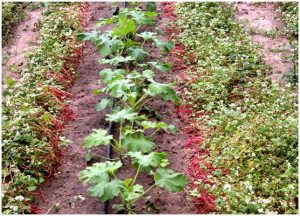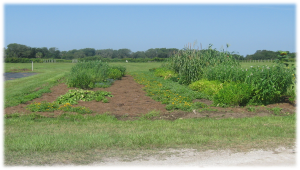Most of you plant a spring vegetable garden with a number of different vegetable types. However, you may not realize that you are improving the health of your soil and your crops by planting a diverse garden. Intercropping is a gardening practice of growing different crops in the same field. When planting a mixture of crops in the same field year after year, it is important to rotate the location of each type of vegetable. This is a practice known as crop rotation. Intercropping and crop rotation will help reduce insect pest populations, increase beneficial insect populations, and reduce weed populations.
Crop Diversity
Growing plants in your garden that pest insects don’t like to eat makes the pests work harder to find what they do like to eat. Studies have found reduced whitefly numbers on squash plantings mixed with a crop of buckwheat when compared to squash planted alone. Another crop mixture that may be unintentional, but may work in your favor is a row of crapemyrtles along the edge of your garden. Crapemyrtles will attract the crapemyrtle aphid which will attract predatory insects. When the predatory insects run out of crapemyrtle aphids to eat, they will move to your garden and begin to hunt pest insects on your vegetable crop.
Trap Cropping
A trap crop is a plant that attracts a pest insect away from your food crops. Trap crops work best when planted at the edge of your garden, along a fence row, or in movable containers. A bare space, let’s say 5 feet or so, should be kept between your trap crop and your garden. This will help keep the pests from moving on to your vegetables. When you find a good population of pests on your trap crop then it is time to spray them with insecticide or cut the crop down and remove the debris to a location far from your garden. If your trap crops are planted in containers, then it makes them that much easier to remove from near the garden area.
Cover Crops and Green Manure
Soil organic matter can be increased by the use of green manure and cover crops. Cover crops are generally planted during the off-season, but they can be planted in between vegetable rows and tilled in at a designated time as a green manure. Both cover crops and green manure improve the production of your garden by:
- Suppressing weeds by competing for water, light, and nutrients;
- Holding the soil in place and preventing erosion;
- Scavenging for nutrients that can be utilized in future crops;
- Reducing nematode populations;
- Providing a habitat for beneficial insects.
A number of different crops can serve as cover crops or green manure crops. Most are legumes (bean family) or grasses. A few that you might like to give a try are:
- Cowpeas
- Sunn hemp
- Sorghum-sudangrass
- Winter rye
More detailed information on cover crops and green manure can be found at this link: http://edis.ifas.ufl.edu/aa217.
- Is a Limequat a Lime or a Kumquat? - December 26, 2025
- Gardening in the Panhandle LIVE! Program Summary: Pests of Florida Lawns and Landscape Plants - May 28, 2025
- Fun Facts About Ferns - April 30, 2025


